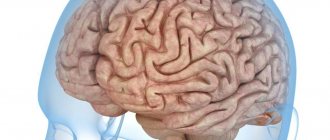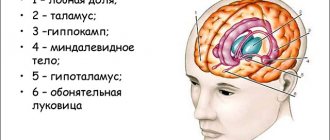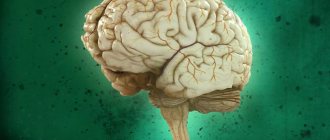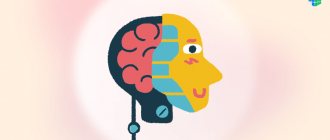Many people have heard that a person only uses 10% of his brain. And these few percentages are enough for the development of information technology, medicines, space exploration and much more. Imagine how life will change if a person starts using his brain to the maximum. But are we really using only a small part of our resources? Let's find out in this article.
Take free logic, idea generation, memory and critical thinking tests now to see how well you use your brain.
What part of the brain does a person use?
It is the brain that determines how a person perceives the world around him. On average, it weighs about 1.5 kg and consists of 100 billion neurons - cells that perceive and transmit information [1].
Content:
- What part of the brain does a person use?
- How did the myth of 10% come about?
- Is it possible to improve brain function?
- Other common myths
- Interesting Facts
As a recent survey of American scientists showed, almost 56% of their compatriots believe that Homo Sapiens uses only 10% of its brain [2]. And we must admit, this belief is very widespread not only in the United States. In fact, this is nothing more than a myth, and neurologists debunked it long ago. Most of the organ is active almost all the time [3]. Scientists conducted research on this topic back in 2009 [1].
Using the capabilities of functional MRI, specialists measured the activity of the organ during the performance of various tasks, and determined that most of the brain remains active almost constantly, even when a person performs very simple actions. Moreover, the organ is awake even when a person is resting or sleeping. But the exact percentage of organ cells that are activated varies from person to person. This indicator also changes depending on what a person does or thinks about.
Online trainers and games
Crossword puzzles and printed Sudoku have been replaced by online services for brain development and training. You can choose anything from online puzzles to educational games that analyze your gaming behavior and adapt to your decisions. The most popular are Vikium, Uplift and Bitreynika. What is it for? First of all, doing exercises can just be fun. Secondly, it allows you to escape from everyday stressful situations with health benefits. From a pragmatic point of view, such exercises improve cognitive abilities, which over time will help you solve life and work problems faster, remember the names of colleagues and acquaintances, and remember important family dates.
How did the myth of 10% come about?
The myth that the human brain only works at 10% capacity is so widespread and has existed for so long that today it is even difficult to accurately determine its original source.
Supposedly, it all started in 1907, when the journal Science published an article by psychologist and writer William James, in which he argued that a person uses only part of his mental resources. True, the scientist did not mention in the article exactly what percentage of his brain Homo Sapiens uses [4]. But where exactly that notorious 10% was mentioned was in Dale Carnegie’s book “How to Win Friends and Influence People,” which was published in 1936. This myth was mentioned as something that a professor at the college where he studied said Carnegie.
By the way, according to scientists, neurons occupy approximately 10% of all brain cells [1]. It is quite possible that it was this information that contributed to the emergence of a myth that continues to be replicated, further strengthening a person’s faith in it.
What is known from scientists' research?
Scientists have repeatedly conducted studies of the human brain and are still studying this organ. Using an MRI machine, scientists were able to visualize the brain and study its active and inactive areas. According to research, not the entire brain is responsible for our actions and processes, but only certain areas. For example, one area is responsible for vision, a completely different one for hearing, a third for speech, etc. Throughout the day, we use almost all areas of the brain. Even to scroll through a feed on social networks, we activate several areas at once - the area of vision, understanding and action. Scientists say that at the moment they have not been able to identify a single inactive part of the brain.
Is it possible to improve brain function?
As with any other organ, the condition of the brain directly depends on a person’s diet and activity. By maintaining a healthy lifestyle, you can actually improve its functioning.
Effect of diet
Poor nutrition can worsen a person’s health and cause the development of heart disease, obesity, and type 2 diabetes. And these diseases, in turn, increase the risk of dementia.
To improve brain health, you should include the following foods in your diet:
- dark-skinned plant foods (such as blueberries, broccoli, spinach), as they contain a lot of vitamin E, and red peppers and sweet potatoes are rich in beta-carotene, both of which are extremely beneficial for the brain;
- fatty fish (salmon, tuna, mackerel) are excellent sources of Omega-3 fatty acids, which improve cognitive function;
- walnuts, pecans (antioxidants contained in nuts also have a beneficial effect on brain health).
Physical activity
The role of physical activity in maintaining brain health cannot be underestimated. It is enough to devote at least 30 minutes to active walking every day to reduce the risk of deterioration in brain function. Swimming, jogging, and cycling are also beneficial.
Mental training
The brain works on the principle of muscles: the more actively it is used, the better it performs its functions. Therefore, you should not ignore special mental training to maintain organ health. By the way, according to one scientific experiment, people who are passionate about logical tasks are 29% less likely to develop dementia [5].
Result:
- The entire brain works (if you are healthy), but there is a huge scope for activity in terms of increasing its productivity.
- The brain has enormous potential and an exciting future lies ahead.
- The less we use something, the faster we will forget how to do it.
- Under living conditions, the brain uses more neurons than in a strictly rule-bound game, such as Go or chess.
Well! Increase efficiency, learn. Remember that it is much easier to restore knowledge than to create new ones, so do not be afraid to weaken old neural connections.
Other common myths
Besides the 10% myth, there are many other misconceptions about the human brain. But most of them already have a scientific refutation.
Left and right hemisphere
Many people have probably heard that creative people have a dominant right hemisphere, while people with a logical type of thinking have a dominant left hemisphere. However, recent research shows that all this is nothing more than a myth. If a person is healthy, both hemispheres are equally developed [6]. The truth is that the hemispheres are actually responsible for performing different types of tasks. Thus, the left controls speech, and the right controls emotions [7].
Effect of alcohol
Long-term alcohol abuse can cause a number of health problems, including problems with the brain. However, it cannot be said that each serving of alcohol kills part of the brain cells - this is a misconception. The damage process is quite complex. For example, it has been proven that if a woman abuses alcohol during pregnancy, there is a high risk that the baby will be born with fetal alcohol syndrome. In people with this disease, the brain is smaller than normal and contains fewer cells. Such children will experience learning difficulties in the future and may have other disabilities.
Best materials of the month
- Coronaviruses: SARS-CoV-2 (COVID-19)
- Antibiotics for the prevention and treatment of COVID-19: how effective are they?
- The most common "office" diseases
- Does vodka kill coronavirus?
- How to stay alive on our roads?
Subliminal messages
There are many misconceptions about so-called subliminal messages and their influence on the human brain. Scientific research has confirmed that information received from the outside during sleep in the form of recorded sounds can cause a certain emotional reaction in a person [8]. But using this method to study foreign languages or other disciplines, as some believe, is inappropriate. Scientific experiments show that this method will help you remember previously known information, but it is impossible to learn new things in this way.
Convolutions
The relief of the human brain consists of grooves and convolutions. There is an opinion that every time a person learns something new, a new convolution is formed on the surface of the organ. But this is a misconception. Convolutions are formed before birth and continue to form in childhood.
Meditation
There are many different meditation techniques, but let's focus on the most seemingly simple one - sit in silence with your eyes closed, focusing on your breathing. Even such a seemingly simple exercise can cause a lot of obstacles. For the first time, it will be extremely difficult to sit for even a minute without annoying thoughts overwhelming your consciousness. However, by gradually stopping your stream of consciousness and returning to your breathing, you will help your brain reset. Daily practices help to get rid of anxiety, reduce the impact of stress and learn to control attention.
Research shows that those who practice meditation every day have a thicker layer of gray matter in precisely those areas that are responsible for attention and psychological flexibility. Training your brain through meditation means that over time you need to put less and less effort into focusing your attention. This means that over time it will become easier for you to concentrate in everyday life when it is necessary - for example, at an important meeting or taking an exam.
Load level
Let's give an example. Let's say a mathematics graduate and a thirty-year-old alcoholic were given the same task: multiply 63 by 58. The action is not at all difficult, but which of them will have to use a larger percentage of the brain to carry it out? It is not surprising to guess that the second one. And why? Because a mathematician is smarter? Not at all. He is simply more trained in this matter, and to solve the example he needs much less workload. However, initially both one and the other person have approximately equal opportunities. And the number of neurons is also approximately the same. The difference is only in the number of relationships between them, but, as you know, broken connections can be restored and even acquired new ones. Therefore, an alcoholic certainly has opportunities for intellectual growth.
Why is this myth popular?
Myth allows us to believe that we are capable of “growth.” He provides an optimistic perspective, suggesting that we are all capable of great things and that each of us has the potential to become an “Einstein”!
Humans are capable of enormous growth and learning, although not all of us can become Einsteins.
It's important to note that debunking this myth in no way means we can't learn new skills. At any point in life, you can learn a new language, learn to juggle, or play an instrument—and be very good at it. This has nothing to do with the presence of “unused” areas in the brain! We are more than capable of acquiring new skills using existing and "used" brain tissue.
This is proven by the fact that humans have invented many skills, such as reading and mathematics, only in the last few thousand years. The brain was not designed to perform these functions, but we are all capable of these skills. The brain can continually adapt existing tissue and reuse it for new skills. If this were not the case, using a computer or smartphone would be almost impossible!
Stress destroys nerve cells, which, in turn, are not restored.
Stress is indeed very harmful to the body. If it is strong, uncontrolled, and prolonged, then it can lead to disruption of a variety of systems: nervous, immune, and endocrine. Most likely, the death of nerve cells as a result of stress also occurs.
As for the nerve cells, most likely they are still being restored. In experiments on animals, for example on mice, we definitely see that yes. In the case of humans, it is more difficult to set up experiments to test this, and there is a scientific debate: some researchers believe that the accumulated indirect evidence is enough to be confident that new neurons are appearing. Others say that in children, probably, yes, but in adults, it’s unlikely. However, what is certain is that people at any age actively form new synapses, that is, connections between neurons. This is, in principle, the basis of learning and long-term memory.
How information enters the brain
1. Initial information is sensory - it is perceived from the senses, and this is what we see, hear and feel
The more attention is focused on sensory sensations, the more information will be stored in memory. And attention increases when a person is interested in something
For example, if he constantly goes to work the same way, his brain seems to go into hibernation and is used at about 5%. If he changes the route, the brain “wakes up” to perceive new information
2. This type of sensory information is stored in memory for a very short time, because there is quite a lot of it received
The brain must separate the more important from the less important in order to move the more important from short-term memory to long-term memory. To do this, it is necessary that the different properties of the object combine and form an image
For example, in order to remember the name of a new acquaintance or his telephone number, it is necessary to associate the information heard and seen with his appearance, the circumstances of the meeting, etc.
4. The accumulated stock of images and concepts endowed with personal meaning allows for mental operations that allow one to penetrate into the depths of the problem and solve certain problems.
5. The form of thinking is a judgment (or statement) - a thought about an object in which its characteristics are revealed through denial or affirmation.
6. Based on judgments, a person makes an inference. For example, seeing puddles on the street in the morning, he comes to the conclusion that it rained at night.
What is good for the brain and its activities
The human brain performs many functions, so it requires more energy compared to other organs. Thanks to this, intelligence improves and new nerve impulses are formed. To stimulate the functional abilities of the organ, it is recommended:
- Read books. Changing genres will be useful, thanks to this your thinking will improve.
- Exercise. Physical activity stimulates the production of the hormone endorphin, which improves mental performance.
- Relaxing during the day will improve the process of assimilation of information.
- Sleep well. Thanks to this, it will be possible to improve concentration and memory.
- To refuse from bad habits. Smoking and drinking alcoholic beverages leads to the death of neurons.
- Follow the rules of rational nutrition.
- Do modeling and drawing. Such activities promote the development of fine motor skills, which improves organ function.
- To learn foreign languages.











